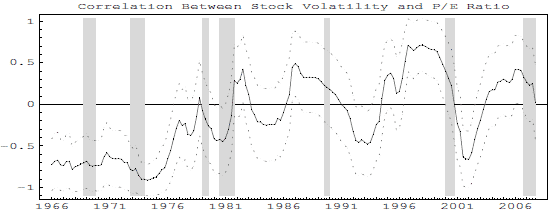Conventional wisdom holds that a low market valuation ratio and a high market volatility both relate positively to future market return. Do valuation ratio and volatility therefore relate negatively to each other with some consistency? If not, why not? In their November 2009 paper entitled “What Ties Return Volatilities to Price Valuations and Fundamentals?”, Alexander David and Pietro Veronesi investigate the relationships between stock and bond valuations and their volatilities in the context of varying investor beliefs about future economic growth and inflation. Using S&P 500 operating earnings from Standard & Poor’s, daily closes of the S&P 500 Index, daily bond yield/return data and monthly values of the Consumer Price Index over the period 1958 through 2008 (51 years), they conclude that:
- The relationship between market valuation ratios and market volatilities varies considerably over the sample period (see the chart below).
- When investors perceive a large change (positive or negative) from the predominant state of medium growth and medium inflation, their uncertainty about economic conditions increases and so therefore do stock and bond return volatilities. However, investors drive valuation ratios based on whether they believe the change is to a better or worse economic state. This decoupling of uncertainty and direction of change produces V-shaped relationships between valuation ratio and volatility for both stocks and bonds.
- For instance:
- On average, there is a negative correlation between stock market price-earnings ratio (P/E) and stock market volatility. However, this correlation may be positive (as in the late 1990s) when investors believe earnings are entering a rare high-growth period. The belief in high growth drives P/E higher, while the rarity of high growth drives return uncertainty/volatility higher.
- On average, there is a negative correlation between bond market yield and bond market return volatility. However, this correlation may be positive (as In the late 1970s) when investors believe that the economy is entering a rare high-inflation period. The belief in high inflation drives yield higher, while the rarity of high inflation drives yield uncertainty/volatility higher. In recent years, belief that the economy is entering a rare deflationary period has reversed this relationship (low return and high volatility).
- On average, there is a positive correlation between stock market earnings yield (E/P) and bond market yield (the Fed Model). However, the correlation can be negative (as in recent years) when investors believe the economy is entering a rare low-growth, deflationary period. The belief in low growth elevates E/P, while the belief in deflation lowers bond yield.
- This approach supports modeling that explains about: 42% of next-year future stock market volatility; 60% of next-year bond market volatility; and, half the next-year variation in the correlation between stock market and bond market returns.
The following chart, taken from the paper, shows the variation in five-year rolling correlations between end-of quarter S&P 500 P/E (based on operating earnings) and stock market volatility calculated from daily returns during that quarter over the period 1958 through 2008. The chart shows that the correlation between stock market volatility and P/E is often strongly positive.

In summary, evidence suggest that investors should consider both the expected the state of the economy and the rareness of that state in in anticipating the relationship between asset class returns and asset class return volatilities.